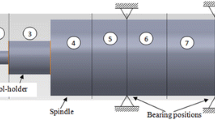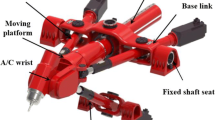Abstract
As a new type, highly efficient hole-making technique, helical milling is widely used to generate holes on composites and composite-metal compounds in the aircraft industry. The accurate prediction of cutting forces and chatter stability are essential for achieving a highly efficient and chatter-free helical milling process by cutting condition optimization. On the basis of a quantitative description of cutting zones corresponding to helical milling operation, a novel dynamic cutting force model is proposed for helical milling in this paper, in which the cutting mechanism and the cutting force contribution on both the peripheral and the front cutting edges are taken into consideration simultaneously. An analytical stability prediction method is also proposed to obtain a novel stability lobe diagram represented by the ratio of the axial to the tangential feed per tooth with regard to the spindle speed using a numerical approach to calculate the average directional cutting force coefficients. The proposed method is capable of predicting the stability lobes accurately for helical milling process where different types of cutting mechanism exist and the axial depth of cut is time varying. It is shown that the numerical predictions agree well with the cutting tests. Finally, the effect of cutting conditions on both the cutting forces and stability limits are thoroughly analyzed.
Similar content being viewed by others
References
Tonshoff HK, Friemuth T, Groppe M (2001) High efficient circular milling: a solution for economical machining of bore holes in composite materials, in: Proceedings of the Third International Conference on High Speed Machining. Metz, France, pp 287–296
Brinksmeier E, Fangmann S (2007) Orbital drilling of high tolerance boreholes. In: International conference on applied production technology (APT07), BIAS-Verlag, pp: 75–84
Tonshoff HK, Spintig W (1994) Machining of holes: developments in drilling technology. Annals CIRP 43(2):551–561
Iyer R, Koshy P, Ng E (2007) Helical milling: an enabling technology for hard machining precision holes in AISI D2 tool steel. Int J Mach Tool Manuf 47(2):205–210
Denkena B, Boehnke D, Dege JH (2008) Helical milling of CFRP–titanium layer compounds. CIRP J Manuf Sci Technol 1(2):64–69
Brinksmeier E, Sascha F, Meyer I (2008) Orbital drilling kinematics. Prod Eng Res Devel 2(3):277–283
Li ZQ, Liu Q (2013) Surface topography and roughness in hole-making by helical milling. Int J Adv Manuf Technol 66(9–12):1415–1425
Zhang L, Zheng L (2004) Prediction of cutting forces in milling of circular corner profiles. Int J Mach Tools Manuf 44(2–3):225–235
Li ZQ, Liu Q (2007) Prediction of cutting forces for circular corner milling, in: International Conference on Mechanical Engineering and Mechanics. Wuxi, China, pp 1283–1289
Kardes N, Altintas Y (2007) Mechanics and dynamics of the circular milling process. J Manuf Sci Eng Trans ASME 129(1):21–31
Ko JH, Altintas Y (2007) Dynamics and stability of plunge milling operations. J Manuf Sci Eng Trans ASME 129(1):32–40
Altintas Y, Ko JH (2006) Chatter stability of plunge milling. CIRP Ann Manuf Technol 55:361–364
Ko JH, Altintas Y (2007) Time domain model of plunge milling operation. Int J Mach Tool Manuf 47(9):1351–1361
Wang HY, Qin XD, Ren CZ, Wang Q (2010) Prediction of cutting forces in helical milling process. Int J Adv Manuf Technol 58(9–12):849–859
Liu CY, Wang G, Dargusch MS (2012) Modeling, simulation and experimental investigation of cutting forces during helical milling operations. Int J Adv Manuf Technol 63(9–12):839–850
Engin S, Altintas Y (2001) Mechanics and dynamics of general milling cutters Part II: inserted cutters. Int J Mach Tool Manuf 41(15):2213–2231
Li ZQ, Liu Q (2010) Modeling and analytical solution of chatter stability for T-slot milling. Chin J Mech Eng 23(1):88–93
Li ZQ, Liu Q, Yuan SM, Huang KS (2013) Prediction of dynamic cutting force and regenerative chatter stability in inserted cutters milling. Chin J Mech Eng 26(3):555–563
Li ZQ, Liu Q (2010) Modeling and simulation of chatter stability for circular milling. J Mech Eng 46(7):181–186 (in Chinese)
Bravo U, Altuzarra O, de Lacalle LN L´p, Sa´nchez JA, Campa FJ (2005) Stability limits of milling considering the flexibility of the work-piece and the machine. Int J Mach Tool Manuf 45(15):1669–1680
Arnaud L, Dessein G, Cazenave-Larroche G (2006) Integration of dynamic behavior variation in the stability lobes method 3D lobes construction and application to thin-walled structure milling. Int J Adv Manuf Technol 27(7–8):638–644
Author information
Authors and Affiliations
Corresponding author
Rights and permissions
About this article
Cite this article
Li, Z., Liu, Q., Ming, X. et al. Cutting force prediction and analytical solution of regenerative chatter stability for helical milling operation. Int J Adv Manuf Technol 73, 433–442 (2014). https://doi.org/10.1007/s00170-014-5793-8
Received:
Accepted:
Published:
Issue Date:
DOI: https://doi.org/10.1007/s00170-014-5793-8




